Endler’s Livebeareris a species of warm water fish habituating in Venezuelan rivers rich in algae. Male and female body length is approximately 2.5 cm and 4.5 cm, respectively. They were originally discovered by Franklyn F. Bond in 1937 andreconfirmed by John Endler in 1975 in Northeastern Venezuela, in Laguna de Patos.
They coexist with P. reticulata but they are not interbreeding. The last being characteristic for the same region is much more common in areas where P. wingei thrive. It is postulated that this is related with the cold running water bio-habitat, which is characteristic for guppies.
Table of Contents
Endler’s Livebearer Overview
|
Information Chart |
Endler’s Livebearer |
|
Scientific Name: |
Poecilia wingei |
|
Family: |
Endlers |
|
Care Level: |
Easy |
|
Temperament: |
Peaceful |
|
Color: |
Males are fluorescent; females are silver colored. |
|
Lifespan: |
up to 3 years |
|
Size: |
up to 3 – 4 cm (~ 1.5 – 2 inches) |
|
Diet: |
Omnivore |
|
Minimum Tank Size: |
10 gallons (~40 liters) |
|
Temperature: |
22 – 28 °C (72 – 82 °F) |
|
Water Conditions: |
0ppm ammonia, 0ppm nitrite, <20ppm nitrate |
|
Tank Mate Compatibility |
peaceful |
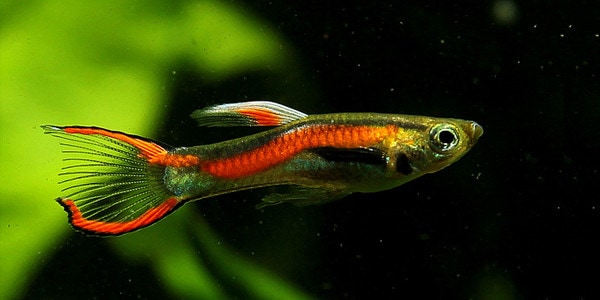
Endler’s Livebearer Appearance
Types of Endler’s Livebearer
A distinction between pure and hybridized endlers’ strains is made by categorizing them into two groups.
- Endlers from the N Class are not exposed to hybridization in any way. N class Endlers are pure strains because they are obtained from a natural population in Venezuela, where they originated.
- P Class Endlers have inherited several N Class Endlers features; however, they do not carry papers to prove their lineage.
- Hybrid Endler is often referred to as a plug-in hybrid. They are classified under the K category. These are the offspring produced due to the crossbreeding of guppies or other livebearers with guppy hybrids.
The Lifespan Of Endler’s Livebearer
The typical lifespan of an Endler‘s Livebearer is two and three years. According to several reviews, Endler’s livebearers cannot live for more than two years, especially after introducing them into the fresh water tank. Some die off instantaneously, but few live up to 2 years.
A combination of circumstances, including less-than-optimal tank conditions and a limited genetic resource pool, is most likely to be blamed for deaths among Endler’s Livebearers.
Unfortunately, female livebearers live shorter than male Endler’s livebearers, which is true in most circumstances. It is due to the creature’s body’s toll due to its recurrent spawning cycles.
Endler’s Livebearer Size
The typical Endler’s livebearer typically grows up to 1.8 inches when they are fully grown. These fishes aren’t as giant as guppies, and in some cases, the female species may grow taller than males. Female Poecilia winger may grow up to two inches in length, and in some instances even more!
Natural Habitat And Origin
Poecilia winger is the binomial name given to the Endler’s livebearer, and it translates as “winged one” in English.
In 1937, Franklyn F. Bond discovered the first specimens of this vividly colored small fish species in the Laguna de Patos, Cumana, in Venezuela’s north-eastern region, and named it after him.
Because Dr. John Endler discovered this species in 1975, who also happens to carry the species’ namesake, its name has garnered worldwide notoriety in the aquarium trade. These traders are indigenous to Venezuela’s Paria Peninsula and the Endlers.
Significant populations may be found in freshwater lagoons and associated streams across Venezuela, with notably large people in the Campoma and Buena Vista lagoons and the Carpano area in the country’s north-eastern portion.
You can also find these creatures in the Laguna de Patos, the Cumana River, as well as the streams and canals that connect the lagoon with the rest of the globe.
Their native habitat is relatively shallow and flanked by trees, which helps them remain shaded. The fact that they contain hot, hard water with high amounts of salt makes it critical to recreate a similar and comparable environment in the aquarium.
As for tank mates, it must be pointed out this species is most appropriately habituating with similar-sized fish in a community aquarium. Lightly-tempered fish, such as tetras,could be good tank companions. There is a risk of cross-breeding if joined with guppies, thus avoid them as a match. Species tanks should be considered if breeding is desired; females are very competitive and territorial so special consideration should be taken for possible bullying.
The aquarium should be planted with live, floating herbs and adequate amounts of light. Artificial fauna could be a plausible solution if live plants are not found. A 10-gallon (40.5 litres) size tank is spacious enough fora large colony. They can easily jump over the water surface; therefore, adequate protection should be installed on top of the tank to prevent the possibility of exiting the tank.
The water current should not be a problem since these fish are quite active. Temperatures in the range of 75-86° Fahrenheit(24-30ºC) are recommended, especially if hatchlings are expected. Their optimal pH requirement is between neutral and alkaline (pH=7-8.5).Since these fish do not produce large quantities of waste, powerful filtration is not necessary.
Endler’s Livebearer Care & Tank Set-Up
Endler’s Livebearer Tank Size And Specifications
Tank size
A small fish species means we can maintain it in even the tiniest of tanks. A 10 gallon (40 L) tank, on the other hand, is recommended if you wish to keep a group of 5 Endlers in captivity.
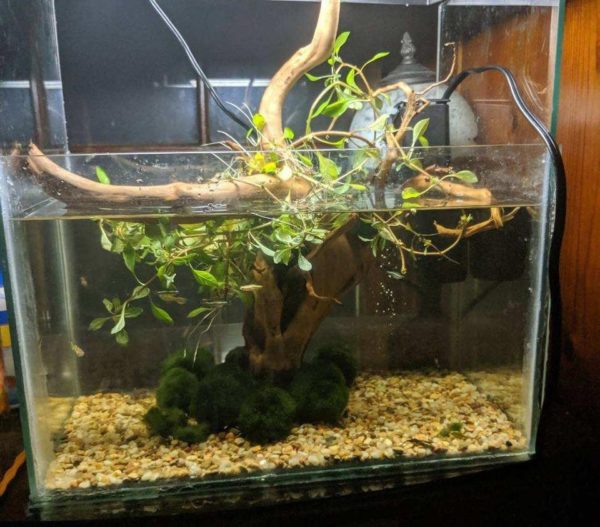
Given that this species is a prolific breeder, you’ll require giant tanks to accommodate a higher number of individuals of this particular species.
Tank specs
This fish needs a well-furnished aquarium to flourish! You should highly inhabit the environment where they reside, with plants and algae because they thrive in the lush-green environment. To an extent inclusion of live plants can be excused in the tank, but it must-have algae for the Endlers to survive.
Endler’s fishes depend on living plants for food and habitat, which they get directly from the aquarium itself. In addition, when the fish spawn, the plants provide a safe refuge for the fish, who are especially susceptible at this time.
Optimum Tank Size For Endler’s Livebearer
The recommended tank size for Endler’s Livebearer is 10 gallons (40 L).
Filter Type
Sponge filters are highly advised for small aquarium setups. In addition to being affordable, easy to maintain, and clean, it provides a vast amount of surface area for the Endlers’ fishes to graze on, and these filters are perfectly safe for the Endlers.
While sponge filters are effective in smaller tanks, they are insufficient in giant tanks. Hence you can opt for Filters that hang on the back of the toilet or canister filters that would best suit this case.
Substrate
Endlers usually travel around the lower levels of the structure to monitor things and hunt for small food particles and plant matters to ingest.
It is highly recommended to use aquarium sand or smooth medium-sized gravel at the bottom of the tank to avoid algae development. Avoid using enormous and coarse stones as they may cause scratches on the Endler’s body. While endlers utilize little pebbles at the bottom of the aquarium, there are high chances of them getting injured by larger stones.
How Many Endler’s Livebearers In A 10-Gallon Tank
5
Water Parameters For Endler’s Livebearer
Water Temperature
The ideal water temperature for Endlers Livebearers is between 72 and 82 degrees Fahrenheit at all times (22 and 28 degrees Celsius). These fishes live in warm water temperatures in the wild hence it is highly essential to replicate the same in the aquarium to maintain their healthy population. Hence, maintain your water tank’s water temperature to the warmer side while petting the Endler’s livebearer fish.
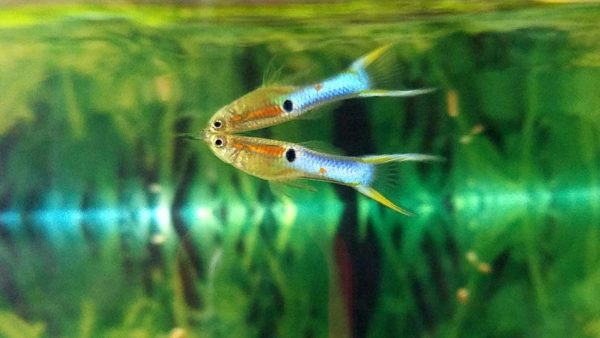
pH Level
The perfect water pH level for Endler’s Livebearer lies between the range of 7.0 to 8.0 in the best of conditions. Despite their small size, Endlers are hardy fish that can tolerate a wide range of climatic conditions. Although a neutral to slightly alkaline pH is optimal, maintaining pH between the given range is highly recommended.
Endler’s Livebearer Tank Landscape
Best Plants For Endler’s Livebearer Tanks
Live floating plants are very beneficial for these fishes to eat since they defecate a lot, forming a large amount of waste that must be broken down and composted.
In addition to floating plants, you can put plants such as Java fern, Java moss, and Dwarf Hairgrass in the front and backdrop of the water feature.
Decorations For Endler’s Livebearer Tanks
Endlers flourish in the aquarium with many hiding places and a diverse collection of other pebbles and stones. As a result, they experience less stress and protection from other fish who may be interested in hunting down endlers as a meal in the future.
Lighting For Endler’s Livebearer Tanks
Aquarium lighting should be bright and diffused, and an LED light fixture is the best choice for this purpose. Use the timer to adjust the light brightness in your aquarium for better handling.
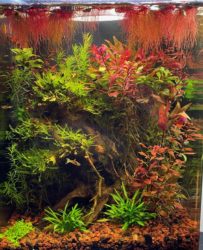
Feeding Endler’s Livebearer
Because Endler’s livebearers are omnivores in the wild, this implies that they consume a range of items such as micro-insects and algae, as well as plant residues to survive. This diet should be mimicked as closely as possible in the home aquarium to ensure that the fish get the best nutrition possible. It may be accomplished by the use of high-quality flake food, as well as live or frozen food items.
The best food for a pet in captivity is a standard diet of dry flakes or pellets available at most pet stores. Keep an eye out for a well-balanced product that has been intended to boost their coloring results.
In addition to commercial food, you may bring live, frozen, or freeze-dried snacks to accompany the commercial cuisine and finish dinner for the fish. Their ravenous appetites are satiated by high-protein foods like bloodworms, daphnia, immature brine shrimp, and black worms, amongst other things.
Best Diet For Endler’s Livebearer
As an omnivorous fish species, they have a wide range of feeds they can consume, which may include algae or any suitable-sized fauna. The issue in their diet is related to the particle size of their food since they have a small mouth opening. If the feeds are purchased in large pellets, they need to be reduced in size by crushing prior to feeding the fish.
Bloodworms and brine shrimp are suitable food choices for this species, but care must be taken to supplement herbs in their daily feeding regime as well. Algae, which normally grow in the tanks, can serve as a good herb source, forgoing additional vegetable matter. Frozen feed can also be used, but must be mechanically reduced in size.
Endlers are not picky eaters, and you may feed them a wide range of foods, such as the following:
- Frozen or live meals
- Superior-quality fish pellets are available.
- Flaky food
- trace quantities of vegetable materials
Before feeding your Endlers, make sure to grind large flake meals into smaller pieces to guarantee that they do not have difficulty ingesting them because of their tiny size and narrow jaws.
How Often Should You Feed Endler’s Livebearer?
Endlers should be fed once or twice a day, and it is crucial to provide them with minor amounts of food that they can consume in a short period to ensure their survival.
Endler’s Livebearer Behavior And Temperament
It is common for Endler’s livebearers to be highly active. They like swimming and exploring the various areas of the aquarium in which they are housed.
Additional behaviors these microorganisms show include:
- Feeding on algae.
- Peeking through the tank glass.
- Taking part in interactive displays with other visitors.
Due to their inquisitive nature, there are scenarios in which they often approach a task to investigate it, chew at your fingers, or even come close to cleaning devices without fear of getting wounded.
Are Endler’s Livebearer Lone Or Societal?
Males are typically reserved, while females may be violent and territorial, which is why a high number of males are required to provide a peaceful atmosphere for females. Generally, they will engage with one another and shoal together in the water without being aggressive against one another, although this is not always the case, especially in large groups.
Endler’s Livebearer Tank Mates
To maintain them in a general environment, it is best to keep them in a single species tank rather than a group of other species. For the time being, though, here are some recommendations for fish tank mates for your fish.
- Cherry barb
- Dwarf gourami
- Neon tetra
- Corydoras catfish
- Honey gourami
- White cloud
- Glassfish
- Ember tetra
- Glowlight Tetra
Ideal Endler’s Livebearer Tank Mates
Several appropriate and serene fishes may be utilized as tank mates for these guppies. They don’t necessarily have to be with their kind of species. All that matters is their natural habitat and peaceful tankmates to be happier in their new home. It is also possible to succeed Endler’s livebearers in combination with a betta, provided that the Endlers fish is introduced without stress initially.
Bad Tank Mates For Endler’s Livebearer
Even though they are quiet fish, there are certain limits on the kind of tank mates that you may maintain with them. One of the most common mistakes people make is to keep other popular guppy species with them in the same tank, which is not recommended.
Endlers should be kept away from the majority of crayfish and freshwater crabs. Even the tiniest African Dwarf Frogs can catch them and attempt to eat them whenever feasible.
Breeding Endler’s Livebearer
Because this fish has been raised in captivity for an extended time, it is easy to breed them in a home aquarium. You may expect them to produce as quickly as any other guppies, just like the rest of the other guppies population.
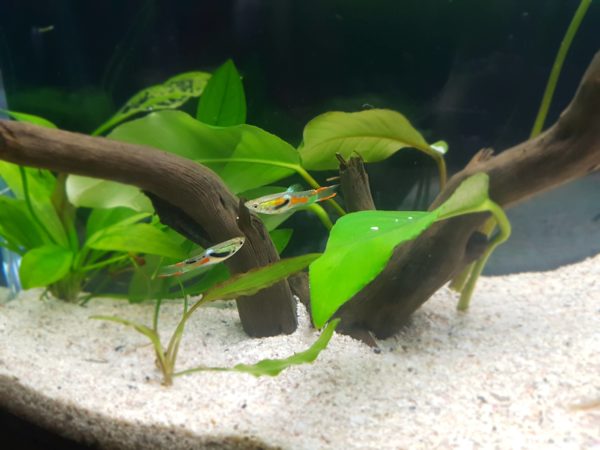
So, all you have to do to encourage them to breed is ensure that your school has both male and female fish, and the rest will be taken care of by the fish themselves. They will continue to breed endlessly if allowed to do so. This is precisely why you need more females in the tank than males to prevent the same female fish from getting pregnant too often, which may pose some harmful threats to her health.
As previously mentioned, if breeding is desired, a community tank habitat is required. They are quite easy breeders, but care must be taken in male-female ratio (1:1). If this ratio is in favor of males,the females will be in jeopardy of harassment. Another way to prevent this is high-density herb planting in the aquarium, which would make obscuring the visual contact with the counter sex mates. They produce broods in cycles of 23-24 days, the size varying 5-25, depending on the age and according to body size.
Gravid females should be isolated in a separate tank prior to birthing, henceforth, they should be returned to the main aquarium. Nets or traps are not recommended for the fry since they are not spacious enough for their size. Following the birth, fry can accept brine shrimp or powdered flake, which is not a problem considering their large size.
In 3-5 weeks males develop mature coloration, whereas females are capable of producing younglings at 2 months of age. Regular feeding of the fry is necessary for proper and optimal development.
Endler’s Livebearer Breeding Level
Easy
Endler’s Livebearer Sexual Dimorphism?
Sexual dimorphism is well pronounced; males are smaller and more brightly colored in comparison to females, combining yellow, orange, green, and blue colors of their scales. Females are lighter colored combining yellow and green colors. Males have narrower bellies compared to females and one of the most recognizable signs in males is the anal fin, which is used during the breeding (gonopodium).
To distinguish between males and females, you can follow the following guideline-
On average, males are about an inch shorter than females, while females are slightly taller than male species. Their outer layer has a vast collection of colors and patterns ranging from dark black to bright orange to blue to yellow to red and metallic green and various textures.
Female Endlers usually are 1.8 inches in length. However, they may grow to be as long as 2 inches. Male Endlers are typically 1.8 inches in length. Male zebra finches are brilliantly colored, characterized with vibrant colored tints and patterns, while female zebra finches are stouter and duller in color (light silver or gold).
Endler’s Livebearer Common Diseases and their Treatment
Ich
Ich is one of the most common infectious-diseases of Endler’s livebearer fish. It is commonly manifested by the appearance of white spots on the body. Additionally, parasites, bacteria, and fungi can be a huge problem due to a decreased amount of oxygen, pollution, increased level of ammonia,and crowded fish population in the tank.
They experience Ich, parasites, and fin rot, to mention a few of the more significant issues you may witness.
Disease caused by Ich is a parasite illness that often affects fish when they are stressed.
If the water parameters in the tank are out of balance, then livebearers have a greater chance of contracting this illness.
It’s conceivable when the temperature ranges are inaccurate or if there is an excessive amount of ammonia in the water.
Facts About Endler’s Livebearer
- Endler’s livebearers are freshwater fish prized for their brilliant colors. They are unique guppies that can only be found in freshwater. They are endangered species.
- Endler’s livebearers are a prevalent fish to keep since they blend well with a broad range of fish breeds and are extremely easy to care for. It is also a powerful fish in nature, making it a good choice for newbie aquarists.
- Endlers are a very active kind of fish, and they are always swimming about the tank, keeping themselves entertained. If feasible, supply these fish with a large amount of tank area so that they may spend their time exploring their surroundings.
- Males tend to be smaller and more streamlined in appearance than females, and their fur is often colored in shades of orange, black, green, and blue. Generally speaking, females have a light green or brown color with no patterning.
- You should be cautious while adding guppy fish to your Endlers aquarium since they will breed with them, and your tank may get overwhelmed by their unlike and cross-bred offspring.
Is Endler’s Livebearer Right For You?
Endler’s livebearers are fantastic freshwater fish to have as pets, and we highly suggest them to everyone. You can’t go wrong with them because of their vibrant colors, high level of activity, and stern disposition.
FAQ
Is It True That Endlers Create More Garbage Than The General Public?
Due to the high quantity of waste produced by endless, live plants may benefit them.
Endlers make a considerable amount of trash, which must be broken down and composted.
How Many Endlers Should Be Maintained In The Same Place At Any One Moment?
In the initial days, start with a trio of one male and two female fish in a 10-gallon aquarium to get things started. To fill a 20-gallon aquarium, purchase six to nine of them at a once.
Is Endlers A Monster That Only Exists At Night?
Their habits include foraging for food at night and maybe being timid at first, but when they are in groups of three or more, they get more confident, and you will observe them cruising about looking for leftover food. They are not hostile in any way.
Conclusion
Many “ Endlers” fishes sold in shops and by hobbyists today are referred to as hybrids of two or more different species. Breeding Endler’s livebearers (Poecilia winger) with guppies (Poecilia reticulata) may produce healthy offspring, and these hybrids are substantially more common than previously known wild strains of the species. While their care requirements are almost identical, they make a highly vivid and eye-catching addition to any home aquarium!
No related posts.
